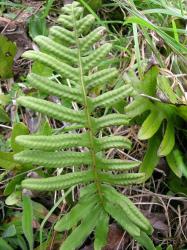Epiphytic (not NZ), rupestral or terrestrial ferns (NZ). Rhizomes short (not NZ) to long-creeping (NZ), terete, lacking cavities, occasionally pruinose (not NZ), scaly. Rhizome scales non-clathrate, squarrose. Fronds monomorphic to dimorphic, articulated to rhizome. Laminae undivided (not NZ) to 1-pinnatisect (NZ), herbaceous to coriaceous, usually glabrous. Veins reticulate or free; areoles with free included veinlets; hydathodes absent. Sori round or slightly elongate, superficial, arranged in 1 (NZ) or 2 rows (not NZ) either side of midrib, served by 1 vein in each areole, not confluent with age, occurring throughout the lamina; paraphyses present (not NZ) or absent (NZ); exindusiate. Spores monolete, bilaterally symmetrical, verrucate to tuberculate and sometimes papillate.
A genus of about 40 species (PPG 1 2016).
This treatment of Polypodium follows Brownsey (in Webb et al. 1988) and Brownsey & Smith-Dodsworth (2000) in recognising a single naturalised species in New Zealand. However, Gilbert (1899) described one new species, Polypodium viride, and one new variety, Polypodium vulgare var. auritum, from New Zealand. These taxa were based on specimens collected by Dr C.H.F. Peters, astronomer-in-chief on the Transit of Venus expedition to New Zealand in 1874. Peters was based in Queenstown and whilst waiting for an observatory to be built he collected ferns for Benjamin Gilbert back in America. Some 25 years later Gilbert described a new species and variety based on these collections, but they have been largely ignored ever since.
Morton (1958) wrote a short paper on the two names, having succeeded in locating the Gilbert herbarium, previously thought to have been lost. He illustrated the holotype of P. viride and suggested that it was the common polypody of the eastern USA – Polypodium vulgare var. virginianum (now treated as a distinct tetraploid species, P. virginianum L.). Since no other species of Polypodium were then known from New Zealand, Morton concluded that Gilbert had described the species from American material inadvertently mixed up with Peters’ New Zealand collections. He made no comment about the identity of the other taxon, P. vulgare var. auritum.
The fact that Polypodium is now known to be naturalised in New Zealand, albeit a long way from Queenstown, suggests the possibility that Peters’ collection may be the first known record. It also raises the question of whether the more recent collections are correctly identified as P. vulgare rather than the closely related P. virginianum. However, the latter species can be identified by its very distinctive paraphyses, which are almost as large as the sporangia and characteristically gland-tipped (see Shivas 1961, fig. 16). Morton (1958) noted that these paraphyses were present in the type specimen of P. viride, confirming the identity of that plant as P. virginianum. However, plants collected in New Zealand recently lack these paraphyses and are a different species. It is very likely, therefore, that Morton was correct, and that P. viride is actually an American specimen of P. virginianum which became mixed up with Gilbert’s New Zealand specimens.
Both of Gilbert’s names are here excluded from the New Zealand flora.
Widely distributed in the Americas, and across Eurasia extending south to the Himalayas, Taiwan and southern Africa. The majority of species occur in the American tropics. One species naturalised in New Zealand.
| Category | Number |
|---|---|
| Exotic: Fully Naturalised | 1 |
| Total | 1 |
n = 37, 74; 2n = 74, 111, 148 (Hennipman et al. 1990).




